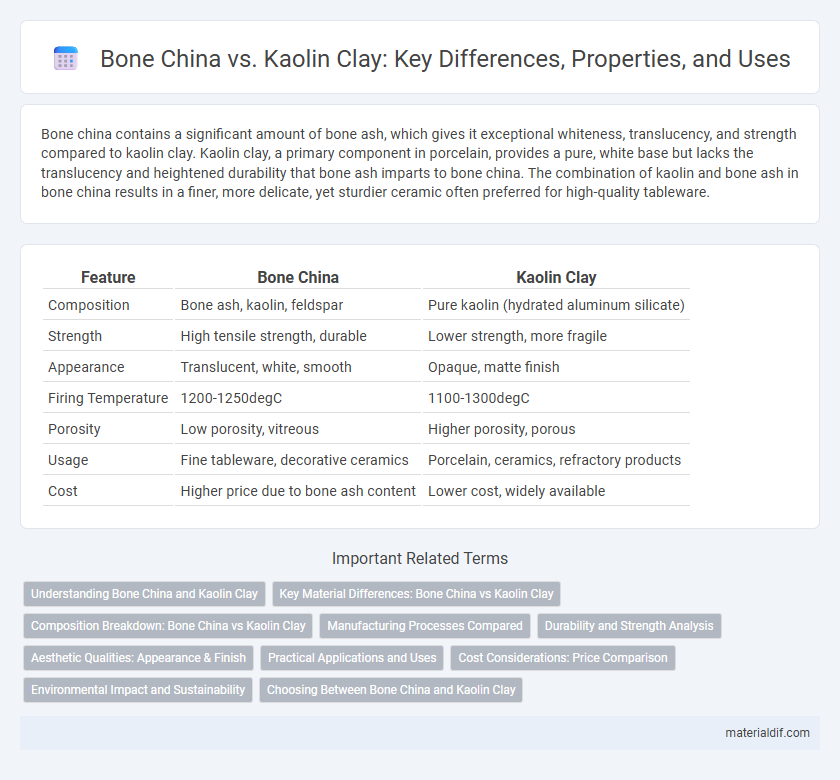Bone china contains a significant amount of bone ash, which gives it exceptional whiteness, translucency, and strength compared to kaolin clay. Kaolin clay, a primary component in porcelain, provides a pure, white base but lacks the translucency and heightened durability that bone ash imparts to bone china. The combination of kaolin and bone ash in bone china results in a finer, more delicate, yet sturdier ceramic often preferred for high-quality tableware.
Table of Comparison
| Feature | Bone China | Kaolin Clay |
|---|---|---|
| Composition | Bone ash, kaolin, feldspar | Pure kaolin (hydrated aluminum silicate) |
| Strength | High tensile strength, durable | Lower strength, more fragile |
| Appearance | Translucent, white, smooth | Opaque, matte finish |
| Firing Temperature | 1200-1250degC | 1100-1300degC |
| Porosity | Low porosity, vitreous | Higher porosity, porous |
| Usage | Fine tableware, decorative ceramics | Porcelain, ceramics, refractory products |
| Cost | Higher price due to bone ash content | Lower cost, widely available |
Understanding Bone China and Kaolin Clay
Bone china contains a significant proportion of bone ash, giving it exceptional whiteness, translucency, and durability compared to traditional ceramics. Kaolin clay, a primary component in both porcelain and bone china, provides plasticity and strength essential for shaping and firing delicate wares. Understanding these materials highlights bone china's unique combination of kaolin clay's malleability with bone ash's mechanical resilience, making it prized in fine tableware.
Key Material Differences: Bone China vs Kaolin Clay
Bone china contains about 25-50% bone ash, enhancing its strength and translucency, while kaolin clay, a primary component of porcelain, is a pure, white clay mineral known for its high plasticity and whiteness. The calcium phosphate in bone china contributes to its unique durability and delicate appearance, contrasting with kaolin's natural composition of hydrated aluminum silicate, which provides rigidity and a matte finish. These material differences affect firing temperatures, with bone china requiring lower temperatures (around 1200degC) compared to kaolin-based porcelain (up to 1400degC), influencing production techniques and final properties.
Composition Breakdown: Bone China vs Kaolin Clay
Bone china primarily consists of 25-50% bone ash, 25-30% kaolin clay, and 25-30% feldspar, resulting in a translucent and highly durable ceramic. Kaolin clay, on the other hand, is a pure white clay mineral composed mainly of kaolinite, with a chemical formula of Al2Si2O5(OH)4, and lacks the added bone ash that enhances strength and translucency in bone china. The addition of bone ash in bone china significantly improves its mechanical properties and aesthetic qualities compared to the relatively dense and opaque structure of pure kaolin clay ceramics.
Manufacturing Processes Compared
Bone china involves a complex manufacturing process where bone ash, feldspar, and kaolin clay are finely mixed and fired at high temperatures to achieve its characteristic translucency and strength. Kaolin clay, primarily used in porcelain production, undergoes a simpler process of shaping and firing at lower temperatures, emphasizing purity and whiteness. The addition of bone ash in bone china enhances durability and whiteness, differentiating its manufacturing requirements from the more straightforward processing of pure kaolin clay.
Durability and Strength Analysis
Bone china, made by incorporating bone ash into kaolin clay, exhibits superior durability and strength compared to pure kaolin clay porcelain. The calcium phosphate in bone ash enhances the material's translucency and reduces brittleness, resulting in higher resistance to chipping and cracking. Kaolin clay, while valued for its whiteness and plasticity, generally produces ceramics with lower toughness and mechanical strength than bone china.
Aesthetic Qualities: Appearance & Finish
Bone china exhibits a translucent and delicate appearance with a smooth, glossy finish that enhances its refined elegance. Kaolin clay produces a more opaque, matte surface with subtle textures that emphasize natural, earthy aesthetics. The contrast between bone china's luminous sheen and kaolin's understated finish defines their distinctive visual appeal in ceramics.
Practical Applications and Uses
Bone china, composed primarily of bone ash, offers exceptional translucency and strength, making it ideal for fine tableware and decorative items requiring durability and elegance. Kaolin clay, a pure white clay mineral, is widely used in ceramics, porcelain, and paper production due to its plasticity and high firing temperature resistance. Practical applications of bone china focus on luxury dinnerware and collectibles, while kaolin clay's versatility extends to industrial ceramics, cosmetics, and refractory materials.
Cost Considerations: Price Comparison
Bone china typically commands a higher price point than kaolin clay due to its refined composition that includes bone ash, contributing to its translucency and strength. Kaolin clay, a primary ingredient in porcelain production, is more affordable and widely available, making it a cost-effective choice for mass production. The cost gap reflects differences in raw material sourcing, manufacturing complexity, and final product quality, with bone china positioned as a premium option in the ceramics market.
Environmental Impact and Sustainability
Bone china, containing bone ash, has a higher environmental footprint due to ethical concerns around animal-derived materials and energy-intensive firing processes. Kaolin clay, a primary ingredient in porcelain, is more sustainable, sourced from natural mineral deposits with minimal ecological disruption when responsibly mined. Both materials require significant energy for kiln firing, yet kaolin's plant-based origin and abundant availability make it a greener alternative in ceramic production.
Choosing Between Bone China and Kaolin Clay
Choosing between bone china and kaolin clay depends on the desired properties and application of the ceramic product. Bone china, made with bone ash, offers superior translucency, whiteness, and strength, ideal for fine tableware and decorative pieces. Kaolin clay, a pure white clay mineral, provides excellent plasticity and durability, making it suitable for porcelain, ceramics, and industrial uses requiring high thermal resistance.
Bone china vs Kaolin clay Infographic

 materialdif.com
materialdif.com